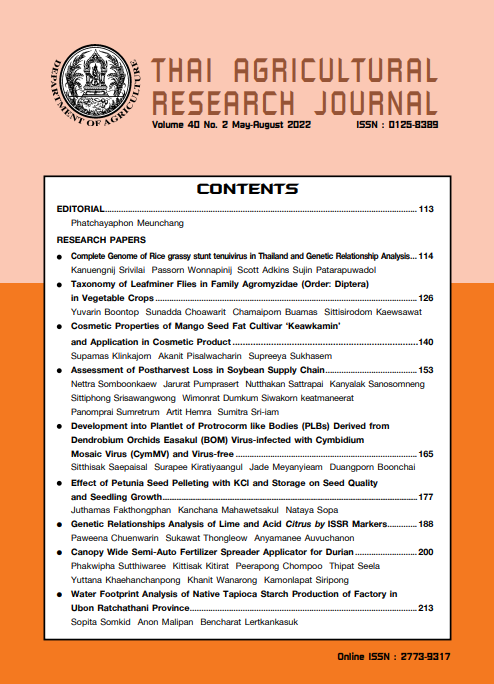Development into Plantlet of Protrocorm like Bodies (PLBs) Derived from Dendrobium Orchids Easakul (BOM) Virus-infected with Cymbidium Mosaic Virus (CymMV) and Virus-free
DOI:
https://doi.org/10.14456/thaidoa-agres.2022.14Keywords:
Cymbidium mosaic virus (CyMV), Dendrobium, compare growth, flower qualityAbstract
Orchid genus Dendrobium Sonia Earsakul (BOM) has a high rate of infection with the Cymbidium mosaic virus (CymMV) due to the use of propagating techniques of dividing or cutting stem from the virus-infected mother plant. This study investigated effects of CymMV on the growth and development of BOM orchids, by taking the bud fragments of the virus-free and virus-infected orchid and induced the generation of protocorm-like bodies (PLBs) and compared on the formation and the number of PLBs. Results showed that, at 45 days the number of PLBs from virus-free orchids was 2 times over those from virus-infected orchids, and at 65 days the number of PLBs from virus-free orchids increased by 2.5 times more than those from virus-infected orchids and was statistically significant different. When PLBs were cultured on a modified Vacin and Went (VW) medium to induce PLBs to plantlets, virus-free PLBs developed into large plantlets three times faster than those from virus-infected which were also statistically significant different. It was also found that the fresh weight and dry weight of virus-free plants were significantly higher than those infected with the virus. Both groups of orchid plantlets were further cultured in modified VW medium for induction into young plants (transitional stage) to compare growth rates. It was found that after 120 days of culturing, the virus-free plantlets grew 20 percent faster than the virus-infected plantlets, and the young virus-free plants had the height and the mean of the number of roots more than 2 times to the virus-infected plants. When the plantlets were taken out of the culture bottle and cultured continuously for 10 months to compare the growth and development of the inflorescences. It was found that the small and medium-sized virus-free plants had larger leaf sizes (leaf width andlength) than virus-infected plants which was statistically significant different. At 6 -10 months of age, virus-free plants were larger and had a 35 % faster flowering rate than virus-infected plants.
References
พิสุทธิ์ เอกอำนวย. 2553. โรคและแมลงศัตรูพืชที่สำคัญ. พิมพ์ครั้งที่ 3. อมรินทร์พริ้นติ้งแอนด์พับลิชชิ่ง, กรุงเทพฯ. 591 หน้า.
สุรภี กีรติยะอังกูร. 2554. โรคของกล้วยไม้จากเชื้อไวรัส และการป้องกันกำจัด. เอกสารวิชาการเผยแพร่ กรมวิชาการเกษตร, กรุงเทพ. 12 หน้า.
สุรภี กีรติยะอังกูร วันเพ็ญ ศรีทองชัย เยาวภา ตันติวาณิช และสิทธิศักดิ์ แสไพศาล. 2554. การพัฒนาชุดตรวจสอบไวรัสอย่างง่ายและเทคนิคการผลิตกล้วยไม้ปลอดโรคไวรัส. 56 หน้า.
สิริมา สิริมา บำรุง ดวงพร บุญชัย อัณณ์ชญาณ์ และมงคล ชัยพฤกษ์. 2562. ผลของการติดเชื้อ CyMV ต่อการเจริญเติบโต ผลผลิตและ คุณภาพของกล้วยไม้สกุลหวาย โซเนีย พันธุ์เอียสกุลในสภาพโรงเรือนที่แตกต่างกัน . ว.วิทยาศาสตร์เกษตร. 50(3): 309-322.
อภิญญา วิริยะเกิดชัย. 2564. สินค้ากล้วยไม้. สำนักส่งเสริมการค้าสินค้าเกษตรและอุตสาหกรรม กรมส่งเสริมการค้าระหว่างประเทศ.แหล่งที่มา : https://ditp.go.th/content. สืบค้น: 15 พฤศจิกายน 2564.
ธีระ สูตะบุตร. 2532. โรคไวรัสและโรคคล้ายไวรัสของพืชสำคัญในประเทศไทย. คณะเกษตร มหาวิทยาลัยเกษตรศาสตร์, กรุงเทพฯ. 310 หน้า.
Brunt, A.A., K. Crabtree, M.J. Dallwitz, A.J. Gibbs and L. Watson. 1996. Viruses of Plants: Descriptions and Lists from the VIDE Database. CAB international, Wallingford. 1484 p.
Chang, C., Y.C. Chen, Y.H. Hsu, J.T. Wu, C.C. Hu, W.C. Chang and N.S. Lin. 2005. Transgenic resistance to Cymbidium mosaic virus in Dendrobium expressing the viral capsid protein gene. Transgenic. Res. 14(1): 41–46.
Hu, J.S. and S. Ferreira. 1994. Orchid viruses. Detection, transmission and management of Cymbidium mosaic and Odontoglossum ringspot viruses in Dendrobium in Hawaii. Amer. Orch. Soc. Bull. 63: 896–898.
Jean, C.C., A.Z. Cesar and T.C. Jen. 2020. An Overview of Orchid Protocorm-Like Bodies: Mass Propagation, Biotechnology, Molecular Aspects, and Breeding. Int. J. Mol. Sci. 21(3): 985.
Khentry, Y., A. Paradornuwat, S. Tantiwiwat, S. Phansiri and N. Thaveechai. 2006. Incidence of Cymbidium mosaic virus and Odontoglossum ringspot virus in Dendrobium spp. in Thailand. Crop Prot. 25(9): 926–932.
Liu, F., Y. Han, W. Li, X. Shi, W. Xu and M. Lin. 2013. Incidence of Cymbidium mosaic virus and Odontoglossum ringspot virus affecting Oncidium orchids in Hainan Island, China. Crop. Prot. 54: 176–180.
Mehraj, H., M.M. Alam, S.U. Habiba and H. Mehbub. 2019. LEDs combined with CHO Sources and CCC priming PLB regeneration of Phalaenopsis. Horticulture. 5(2): 34.
Moraes, L.A., K.S. Renate and M.A. Pavan. 2017. Incidence and characterization of viruses infecting orchids in Sao Paulo state, Brazil. Trop. Plant Pathol. 42: 126–131.
Vacin, E.F. and F.W. Went. 1949. Some pH changes in nutrient solutions. Botanical Gazette. 110(4): 605-613.
Wong, S.M., C.G. Chng, Y.H. Lee, K. Tan and F.W. Zetter. 1994. Incidence of Cymbidium mosaic and Odontoglossum ringspot viruses and their significance in orchid cultivation in Singapore. Crop. Prot. 13(3): 235–239.
Zettler, F.W., N.J. Ko, G.C. Wisler, M.S. Elliott and S.M. Wong. 1990. Viruses of orchids and their control. Plant Dis. 74(9): 621- 626.
Downloads
Published
How to Cite
Issue
Section
License
Copyright (c) 2022 Thai Agricultural Research Journal

This work is licensed under a Creative Commons Attribution-NonCommercial-NoDerivatives 4.0 International License.
Thai Agricultural Research Journal



